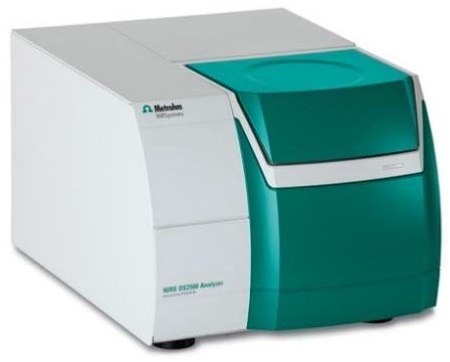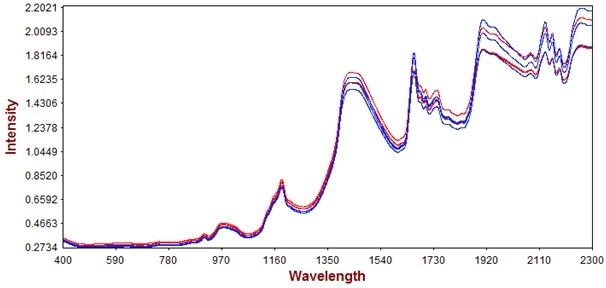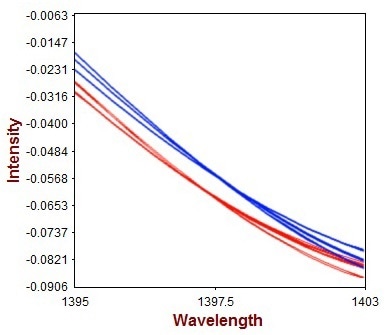Enriching the look and refining the feel of hair are the purposes of using hair conditioners. These cosmetic products are an emulsion of a specified droplet size, containing water and hydrophobic ingredients. The size of the droplets varies between different processing steps and is an important parameter as it affects the conditioner’s efficacy. Hence, the droplet size is one of the quality parameters and must be measured on a regular basis.
Different methods are available to measure the droplet size. Microscopy or laser diffraction particle sizing techniques are the predominantly used methods for this purpose. A rapid alternative quality analytics method to measure the droplet size is vis-NIR spectroscopy.
Experimental
For this experiment, the customer provided two products: One was the unprocessed hair conditioner (A) and the other was the processed conditioner (B), with the droplet size of the formulation ranging from 5-20 μm and 5-50 μm, respectively.
The Metrohm NIRS DS2500 Analyzer (Figure 1) was used to perform the spectral data acquisition over the full range of 400 nm to 2500 nm, with variable spot size. The samples were filled into disposable vials and examined in diffuse reflectance mode.

Figure 1. The NIRS DS2500 Analyzer was used for spectral data acquisition over the full range from 400 nm to 2500 nm.
Table 1. Used equipment and software
| Equipment |
Order code |
| NIRS DS2500 Analyzer |
2.922.0010 |
| NIRS DS2500 Iris |
6.7425.100 |
| Vision Air 2.0 Complete |
6.6072.208 |
The identification and qualification methods were designed based on parameters listed in Tables 2 and 3 using the Vision Air Complete software.
Table 2. Identify method parameters
| Method |
Correlation in Wavelength Space |
| Wavelength regions |
416-1080 nm, 1120-2480 nm |
| Pre-treatments |
2nd derivative, Segment=10.0 nm, Gap=0.0 nm |
Table 3. Qualification method parameters
| Method |
Maximum Distance in Wavelength Space |
| Regions |
1380-1404 nm |
| Pre-treatments |
2nd derivative, Segment=10.0 nm, Gap=0.0 nm |
The purpose of the identification method is to differentiate if an unknown sample is an unprocessed (A) or a processed (B) hair conditioner. If it is possible to allocate the sample to one of those products, the qualification step identifies whether the size of the droplets either above or below the threshold size.
An independent set of samples were used to validate the methods. The Vision Air software was used to complete the predefined identification and qualification analysis automatically after each measurement, giving results within seconds.
Results and Discussion
The raw spectra of the conditioner A (red color) and B (blue color) are shown in Figure 2. Spectral variations can be differentiated independent of baseline shifts by computing the 2nd derivatives of the spectra.

Figure 2. Raw spectra of the unprocessed (red) and processed (blue) products.
Figure 3 shows the 2nd derivative spectra, allowing the products to be identified easily as they can be distinguished clearly. The variation in droplet sizes causes the spectral variation within a product. This spectral variation is applied for the qualification of the various droplet sizes.

Figure 3. 2nd derivative spectra of the unprocessed (red) and the processed (blue) product. The spectral variations observed within the products arise due to different droplet sizes.
As predicted, the unprocessed samples cleared the identification step as they are the right formulation but failed the qualification step as the predicted droplet size was clearly above the limits. On the other hand, the processed samples cleared both the identification and qualification steps, demonstrating the reliable difference between out-of-specification products and products of desired quality.
Summary
This feasibility study developed Vis NIR methods for identification of the formulation and qualification of the droplet morphology. Differentiating between two different intermediate products with droplet sizes ranging from 5-50 µm and 5-20 µm, respectively. Qualitative models were designed based on the acquired spectra. The models were assessed with an external validation and were constantly able to differentiate between the two different types of sample (A and B), demonstrating that Vis NIR spectroscopy is a brilliant technique to relieve the principal methods.
About Metrohm
At Metrohm is one of the world’s most trusted manufacturers of high-precision instruments for chemical analysis. Metrohm was founded in 1943 by engineer Bertold Suhner in Herisau, Switzerland. Today, Metrohm is represented in 120 countries by subsidiaries and exclusive distributors. The global Metrohm Group also includes the Dutch companies Metrohm Applikon and Metrohm Autolab, manufacturers of online analyzers and instruments for electrochemical research, respectively. Recently, the Metrohm Group was joined by Metrohm Raman, a leading manufacturer of handheld Raman spectrometers.
Metrohm is the global market leader in analytical instruments for titration. Instruments for ion chromatography, voltammetry, conductivity, and stability measurement make the Metrohm portfolio for ion analysis complete. Instruments for Near-infrared and Raman spectroscopy are another, strongly growing segment of the Metrohm portfolio.
Metrohm is a problem solver, both in the laboratory and within the industrial process. To this end, the company offers their customers complete solutions, including dedicated analytical instrumentation as well as comprehensive application know-how. More than 30% of the company’s employees at the Metrohm international headquarters in Herisau work in R&D.
Metrohm has been owned 100% by the non-profit Metrohm Foundation since 1982. The Metrohm Foundation, which does not exert any influence on the company’s business operations, sponsors gifted students in the natural sciences, supports charitable and philanthropic purposes and, above all, ensures the independence of the company.
Sponsored Content Policy: News-Medical.net publishes articles and related content that may be derived from sources where we have existing commercial relationships, provided such content adds value to the core editorial ethos of News-Medical.Net which is to educate and inform site visitors interested in medical research, science, medical devices and treatments.